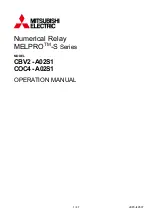
7SG164 Ohmega 400 Series Description of Operation
1 General
The relays provide high speed Distance protection and have independent measuring elements for each fault
condition and zone of operation. This gives a true full scheme operation. The impedance measurement is a
continuous process therefore under impedance starting elements are not required. The relays can include a
complete range of feeder protection features supplemented by control, metering, data storage and fibre optic
data communication capabilities.
Supervisory components and self-monitoring features give a high confidence of full serviceability. A menu-
based interface facilitates user friendly access to relay settings, meters and stored fault data.
The relay can be easily incorporated into substation control and automation systems.
2 Protection Functions
Table 1 illustrates the standard functions and Table 2 shows the standard schemes available in all relay
models;
Mho Characteristics
High Set Overcurrent
3 Zone
A.C. Line Check (SOTF)
Residual Compensation
D.C. Line Check (SOTF)
3 Pole Tripping
V.T. Supervision
Power Swing Blocking
Voltage Memory
Table 1 – Standard Protection Functions
Time Stepped Distance
Blocked Overreach
Permissive Underreach
Permissive Overreach
Table 2 – Standard Schemes
In addition to these standard features, different model numbers are available which have extended
functionality. These extended features are detailed in Section 12 of this manual.
3 Output Contacts
The basic relay model provides 5 output relays, three of which energise changeover contacts, the remaining
two energise normally open contacts. The number of output contacts can be increased by groups of 8, to
give a maximum of 29 output contacts.
Outputs are user programmable to operate from any or all of the protection functions. In addition they can be
programmed to generate outputs for alarm conditions or operate on the energisation of a status input. The
relay “Protection Healthy” output is energised whenever the relay is powered-up and working correctly. If the
self monitoring feature of the relay detects a hardware fault, or the relay power supply is lost, this contact will
drop off.
In their normal mode of operation, output contacts remain energised for at least 100ms, or for the duration of
fault. Alternatively, outputs can be programmed to operate as latching contacts if required. Latched output
relays can be reset either by pressing the TEST/RESET button, by sending an appropriate data
communications command or electrically via a status input.
4 Status Inputs
3 plant status inputs are provided in the basic relay, this can be increased in groups of 8, using additional
modules to give a maximum of 27 inputs. The inputs can be mapped to dedicated functions within the relay
or can be mapped to functional logic blocks or to user defined logic. The inputs can be configured to be high
speed signal channels or have a time delayed pickup or drop off function.
©2011 Siemens Protection Devices Limited
Chapter 1 Page 3 of 12






































